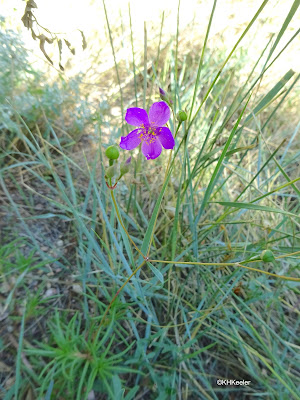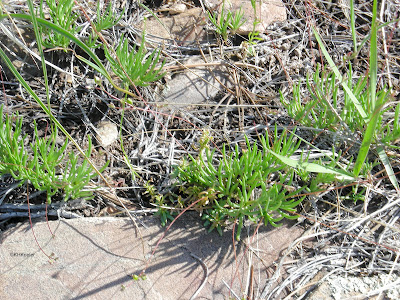I first saw sunbright as little groups of succulent leaves near the plants I was studying, in a rocky grassland in the City of Boulder Open Space.
 |
| sunbright |
Then I came back on a bright morning, and tiny magenta flowers hung in space. What were those?
They were fameflowers, also called flameflowers, genus Phemeranthus, small succulents, native to North America.
 |
Great Plains fameflower,
Phemeranthus calycinus |
The low succulent leaves send up a thin dark stem, like a monofilament line, to stand three or four times the height of the leaves. With buds or developing fruit, it is virtually invisible in the grass. When the flower opens, they are bright magenta, very dramatic.
Phemeranthus is a genus of 25 to 30 species, from North, Central, and South America but none from the Old World. There are 16 North American species. The group was split off from Talinum about 30 years ago; Talinum is an Old World genus with (now) only two American species, in Texas and Florida. However, you can still see Phemeranthus species called Talinum, for example by wildflower sellers.
Phemeranthus was long included in the portulaca family, Portulacaceae, but has been moved, along with its relatives spring beauty (Claytonia) and Indian lettuce (Montia) into their own family, Montiaceae.
 |
| Great Plains fameflower Phemeranthus calycinus |
The name
Phemeranthus is a combination of the Greek words
ephemerus, "lasting for one day," and
anthus, "flower". These bright flowers open only for a few hours of a single day, like 1:30 to 4 pm. They tend to grow in dense populations, so if a pollinator that spots one flower, will likely find others to visit. Some species of
Phemeranthus will set seed from self-pollination, which seems a good back up for making seeds if the flower is so briefly open. However they do it, generally they produce numerous seed pods.
Different species of Phemeranthus are found all across North America. Colorado has one or two species depending upon your authority. Below is the one I saw in Boulder County Open Space
 |
| sunbright or prairie fameflower |
Cryptic isn't it! It is in the center. A little mound of succulent leaves.
Older references call this plant Phemeranthus parviflorus. It is a tiny species, with leaves less than 2" long, and flowers petals just 1/3" long. Its common names are sunbright or small-flower fameflower. Phemeranthus parviflorus has a broad distribution from Texas to North Dakota.
But there is confusion. Perhaps this plant I saw should be called Phemeranthus confertiflorus, New Mexico fameflower. The Flora of Colorado 2nd edition, says the species in Colorado is P. confertiflorus, which she calls sunbright. Kiger in the Flora of North America says P. confertiflorus is a variant of P. parviflorus which he didn't recognize as a separate species because P. parviflorus is so variable. The USDA Plants database has both species, both found from Texas to North Dakota, P. confertiflorus also in New Mexico and Arizona but not eastward, P. parviflorus in a series of Midwestern states but not in New Mexico and Arizona. On the USDA's maps, both are in Colorado. I certainly don't know. The plant I saw was the tiny sunbright, whatever its correct scientific name (the only other species of Phemeranthus reported for Colorado is the larger Phemeranthus calycinus, which might be out on the eastern plains of Colorado although the records are few.)
 |
| sunbright, Phemeranthus, Boulder County |
Thinking this a very pretty plant, this spring I bought three plants of Great Plains fameflower, also called rock-pink fameflower, Phemeranthus calycinum. My resident rabbit immediately ate one but the others, better hidden perhaps, survived to flower. Those are the photos with flowers. I have photographed sunbright's flowers, but the pictures were badly out of focus (tiny flower nowhere near the leaves high on a slim thread in a windy prairie--difficult!)
Here are the leaves of Great Plains fameflower, much larger than sunbright.
And a distance photo, showing it in its brief moment of glory
In the City of Boulder Open Space, most sunbright plants died within a year, but a few grew very big (for sunbright) and lived several years, growing on gravel or amid rocks. In the Nebraska sandhills, I found sunbright up on the slopes of the dunes and another slightly larger species, sand fameflower, Phemeranthus rugospermus, a hundred yards below in the taller grass of the more level sand between dunes. They like hot, rocky or sandy areas where the conditions reduce competition from other plants. Websites from the eastern U.S. find their species in similar places.
The Ramah Navajo used sunbright root bark to treat sores, as a poultice or lotion. Which suggests they could find enough plants to make a medicine. I suspect sunbright and the fameflowers are not so much rare as really inconspicuous plants found in specialized habitats. Watch for them!
Comments and corrections welcome.
References
Ackerfield, J. 2022. Flora of Colorado. 2nd edition. BRIT Press, Fort Worth, Texas.
Kaul, R. B., D. Sutherland and S. Rolfsmeier. 2011. The Flora of Nebraska. University of Nebraska Press. Lincoln, NE.
Kiger, R. W. Phemeranthus Rafenseque. Flora of North America. Accessed 10/7/23.
Minnesota Wildflowers.
Phemeranthus rugospermus (Rough-Seeded Fameflower)
link Accessed 10/7/23.
Moerman, D. E. 1998. Native American Ethnobotany. Timber Press. Portland, OR.
Plant of the Week. Quill Fameflower (
Phemeranthus teretifolius (Pursh.) Raf.) U.S. Forest Service
link
Weber, W.A. and R. C. Wittmann. 2001. Colorado Flora. Eastern Slope. 3rd ed. University Press of Colorado. Boulder, CO.
Weber, W.A. and R. C. Wittmann. 2012. Colorado Flora. Western Slope. 4th ed. University Press of Colorado. Boulder, CO.
Kathy Keeler, A Wandering Botanist







No comments:
Post a Comment